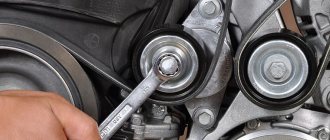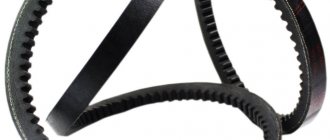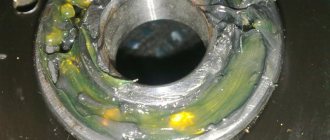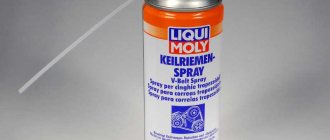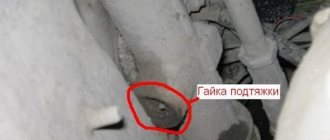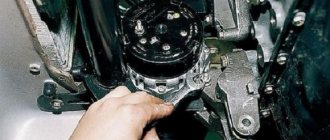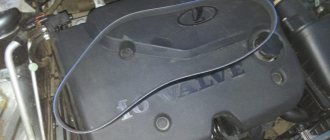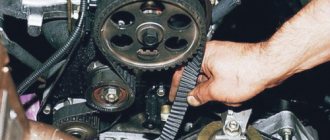The drive belt is whistling - you need to figure out the reasons and, most likely, buy a new one. But for the first time, even the old one can be made to quiet down. The method is folk, words and music too.
It happens that you are driving calmly, the weather is fine, and then somewhere nearby you hear such a sharp and unpleasant whistling sound that passers-by actually draw their heads in. It was the drive belt of one of the cars passing nearby that whistled.
You can hear this cacophony from 50 meters away. How do they drive with such sound accompaniment? This is going to make your brain boil. And most importantly, the whistling does not appear instantly, it begins with occasional whistling, and only then, after some time, it becomes simply unbearable.
Is it really difficult to replace a belt? Yes, I understand, there are different situations, something is missing: either money, or time, or conscience. But you should at least feel sorry for the car if it’s normal to drive like that yourself.
Why does the alternator belt whistle?
The creaking or whistling of the alternator belt occurs due to several reasons, namely:
- Insufficient belt tension;
- Belt wear;
- Ingress of moisture or technical fluid onto the drive;
- Wear of pulleys and tension roller;
Let's look at each of the reasons separately to delve into this topic in more detail.
Weak belt tension
When the belt has insufficient tension, when a load occurs on this drive, it slips, which leads to a characteristic sound - a creaking sound. Fixing such a breakdown is quite simple; you just need to check the belt tension and, if necessary, tighten it according to the car’s operating instructions.
Excessive belt tension can lead to breakdown of the units and this drive, namely failure of the bearings.
Belt wear
Quite often, the cause of a squeaking belt is its wear. Using the belt for a long time without replacing it leads to its stretching to such an extent that tensioning it no longer helps and the creaking cannot be eliminated using this method. Such a belt must be replaced to get rid of extraneous sounds in the car.
Ingress of moisture and technical fluid
When moisture gets onto the generator drive, it wets the pulleys and the belt itself, thereby increasing the slip coefficient, which leads to belt slipping. When the moisture from friction evaporates, the belt stops slipping.
With technical fluids, things are much more complicated. For example, when oil gets on the generator drive, it does not evaporate due to friction and remains on it for a very long time. As you know, oil has an excellent slip coefficient, and if it gets on the belt, it does not allow it to work normally. Antifreeze ingress has exactly the same effect on the belt drive.
Pulley and roller wear
When a pulley or roller wears out, the belt tension decreases, its diameter decreases, thereby making the belt tension weaker, which leads to belt slipping and, consequently, squeaking.
Purpose and types
The main purpose of the alternator belt, as the name suggests, is to transmit rotational motion from the engine crankshaft to the alternator to ensure charging of the car battery and the operation of the car’s electrical system as a whole.
In most cars, the purpose is even broader. Sometimes it rotates the pump (water pump), the air conditioning compressor clutch, the power steering pump, and other rotating mechanisms of the car.
Fig.1
Why is it that in all cars a belt drive is chosen to transmit rotational motion from the crankshaft to the generator, if there are more reliable and durable ones, for example, a gear drive?
Belt drive has several significant advantages:
- simplicity;
- the ability to perform kinematic connections over long distances;
- Perhaps the main advantage is the protective functions.
The protective function of the belt drive is that if the generator (compressor, hydraulic booster, pump) jams, the powerful torque of the engine crankshaft will not destroy the generator and other components. The belt provides slippage. At worst, it will simply break, but the other nodes will remain intact.
The following requirements apply to generator belts:
- reliability (service life is usually at least 30,000 km);
- elasticity, the ability to maintain tensile strength during changes in temperature and humidity throughout the entire service life;
- good anti-slip properties;
- resistance to aggressive agents.
In order to meet these high requirements, manufacturers use different types and technologies for the production of alternator belts:
- wedge - to provide a larger area of contact with the pulley, lateral resistance to slipping;
- poly V-belts - to increase the properties of V-belts;
- toothed poly-V-belts - to increase the flexibility of V-belts;
- woven covering of the non-working area - to increase service life.
A modern alternator belt from an official manufacturer is a high-tech product using high-quality materials. However, no matter how high quality it is, during operation it wears out and its linear dimensions increase
.
While the engine is running in the engine compartment, its operating temperature can vary in the range from – 30 to + 100 degrees. This also causes a change in the geometric dimensions of the alternator belt. To maintain the tension force at a constant level, tension regulators are used.
In cars of the 80s, tension control was often done by changing the geometric position of the generator. In this case, one side of the generator was fixed permanently. The second mount had a groove.
Video - why the alternator belt whistles when cold and how to solve the problem:
If the tension weakened, the second fastening was loosened, the generator was moved using the device, tightening the generator belt, then the fastening bolt was clamped again. A little inconvenient, but no additional rollers, rods or other components.
Currently, three types of tensioners are used:
- roller with eccentric
(the central bolt is loosened, the eccentric bolt is rotated to achieve the required tension, the central bolt is clamped); - a roller with a screw rod
(does not require two keys, tension adjustment is simpler, although the design itself is less reliable); - dynamic tensioners
(self-adaptive, do not require adjustment during operation).
There are car models in which there are no elements for regulating the tension of the alternator belt at all. In this case, it is especially important to select a product from a recommended manufacturer according to the instruction manual.
How to eliminate a whistling alternator belt
If your car has a creaking or whistling alternator belt, this must be eliminated as quickly as possible. First you need to determine the culprit of the problem, be it a belt, roller, dirt or weak tension.
It's a weak stretch
If it turns out that the belt has a weak tension, then it is enough to tighten it to the standard specified in the car’s operating instructions and you can safely continue driving.
Do not overtighten the belt, this can lead to rapid wear of the bearings and their early failure.
Pollution
If there are traces of lubricants (oil or antifreeze) on the pulleys or on the belt itself, they must be eliminated. You can clean the pulleys and belt using carburetor cleaner, as it evaporates quickly and does not leave a greasy residue.
Roller wear
The next step is to inspect the tension roller, which should rotate freely and not bite in certain places, and also not make any extraneous sounds when rotating.
Belt wear
We assess the condition of the belt; it should not be dry or have signs of cracks. An old belt can dry out, losing its meshing properties, which can lead to the belt slipping on the pulleys and, consequently, to extraneous noise and creaking when the engine is running.
Cause of whistling noise when starting the engine
But it really can! I recently looked for the cause myself, changed 3 belts, but a week later the whistle appeared again. The spray also helped for a week. Then all the rollers, by the way, they were still in good condition. I even changed the overrunning clutch on the generator. And only after I changed the crankshaft pulley, the whistle disappeared.
And the most paradoxical thing is that there is no manual or information that if the wear is so much, then it needs to be changed, just like on tires there is a minimum profile height or like on brake discs there is a minimum disc thickness.
When the pulley is worn out , the strands on the poly V-belt slide along the pulley and rub against it until they heat up from friction, i.e. It turns out that the belt seems to have become longer.
You can also save money if you find a belt a couple of millimeters shorter, but this is quite difficult, because... Most manufacturers do not make belts in increments of a couple of millimeters in length.
In conclusion, if you make replacements according to the regulations, then this trouble will not come as a surprise to you!
Briefly about the hanging belt
Belt drive is the most common method of transmitting rotation to the generator rotor. The method has been used for a long time and differs from others in its simplicity: only two pulleys on shafts that are connected by a belt.
The belt itself is responsible for a lot. It is he who is responsible for transmitting rotation from pulley to pulley. You should be aware that one part of the belt is tighter than the other . It is the difference between these tensions that determines the traction force and its coefficient.
The belt provides precise transmission and is quiet in operation. High-quality products are able to withstand long-term loads, smooth out shocks and jerks. They are compact, take up little space, but simultaneously operate several important components of the car: generator, pump, air conditioning compressor and power steering pump.
The generator rotor must rotate constantly. This is facilitated by the belt connection to the crankshaft. The pulleys, which are screwed onto the generator and crankshaft shafts, are connected by a belt, which must be flexible.
The “whistle” of the belt is similar to a disgusting clang. It is caused by the belt slipping. The sound of such a whistle is unpleasant and can be heard at a great distance. Of course, you should not drive in such a situation.
Uneven pulley line
The next reason for belt whistling is misalignment of the pulleys. For proper operation, the generator pulleys and engine shafts must be in line.
To diagnose the problem, you need to use a ruler to measure the level of the pulleys. Elements are considered coaxial only if there are no gaps between the surface of the ruler and the pulleys. This problem can be corrected by eliminating the deformation of the fastening of the hinged part using straightening or simply replacing the pulley.
If it is not possible to check the alignment due to a non-standard front surface or fastening, then the pulleys must be unscrewed. It is necessary to stretch a thread or string between the flanges. Next, we apply a ruler to the flange and, if the elements are parallel, the two pulleys are on the same axis.
Possible repairs
What to do in this situation? The solution depends on the identified malfunction. A loose drive should be tightened. Kalina cars and other front-wheel drive VAZA models have a tension bolt that allows you to adjust the degree of belt tension. To carry out the manipulation, loosen the fastening bolts, then tighten the adjustment bolt a few turns, achieving optimal tension. A correctly tensioned drive should bend no more than 1 cm under hand pressure. If this cannot be achieved even with the bolt tightened to maximum, the belt should be replaced.
If the pulleys become oily, the drive should be removed and the inside should be wiped with alcohol or gasoline. Pulleys are cleaned in the same way. If the belt has been in an oily state for a long time, it is recommended to replace it, since fuels and lubricants destroy rubber. Also, current seals and gaskets must be changed.
In cases where the alternator belt whistles “when cold,” repair is not required. It is permissible to slightly increase the belt tension. However, if the whistling noise disappears after warming up, this is not necessary.
If, as a result of diagnostics, it was revealed that the front bearing of the generator is whistling, it is replaced. To do this, remove the unit from the car, dismantle the front cover and, after removing the faulty bearing, press in a new one. This is also done when the pulley is skewed and the generator shaft is jammed.
First sign
The belt may whistle when starting the engine, while driving, in winter, in rainy weather, etc. The duration of the unpleasant sound can vary from a few seconds to constant as long as the power plant is running.
As we mentioned above, in many cars, the alternator belt additionally ensures the operation of a number of equipment - power steering, air conditioning compressor, which increases the load on the drive and, as a result, the likelihood of a problem becoming higher.
And although many attribute the whistle to the belt drive itself, it may also indicate other malfunctions.
Correct belt tension
If the squeak is caused by weak belt tension, you can adjust it yourself. Formally, the degree of tension depends on the specific car model (some manufacturers even indicate exact force values), but in practice it is adjusted by touch, measuring the belt deflection manually. To do this, press at the point of the belt furthest from the pulleys and rollers with a finger: with the correct tension, the belt should bend by about 10–15 mm.
After adjusting the belt tension, you need to start the engine and listen: the whistle should disappear, and the electrical equipment should work without fluctuations or failures. Otherwise, the adjustment must be repeated.
There are several ways to tension the belt, depending on the design of the adjustment mechanism.
Adjusting arc-shaped bar
To check the tension, you need to press on the belt: it should bend by about 10–15 mm.
In older cars, the belt is tensioned using a so-called bar, which attaches the generator to the engine and is secured with a bolt and nut. The procedure is very simple: having loosened the clamping nut, you need to knock the bar with a hammer or pry bar, changing the position of the generator relative to the engine, and then tighten the nut back.
Adjustment bolt
Another old mechanism still found on cars is tension using a special bolt. Before adjustment, it is necessary to loosen the generator at the lower and upper points, then change its position using the adjusting bolt, while simultaneously controlling the belt tension. Having reached the desired force, you need to tighten the generator mounting nuts back.
Belt self-tensioning
Most modern cars with a poly-V belt do not have manual adjustment: this function is performed by a special automatic tensioner. According to the operating principle, they are divided into three groups: damper, compression spring based and torsion spring based. The latter are most widespread due to their simplicity, reliability of design and compact size. Due to the force of the spring, a constant tension of the drive belt is maintained, and if the force weakens, you simply need to replace the tensioner with a new one.
How often should the drive belt itself be changed? Each automaker has its own recommendations; usually the replacement interval is 45–60 thousand kilometers. However, checking the condition of belts and pulleys (at least visually) should be carried out regularly: for example, at every engine oil change. This will prevent unexpected belt breakage or sudden squeaking.
Given the low cost and light weight, it is wise to always carry a spare drive belt with you, especially on a long trip. Its presence in the trunk will help out in case of a sudden break or detection of critical wear - you won’t have to resort to old-fashioned field repair methods (winding nylon tights around the pulleys instead of a belt) in order to make it to service. And to extend the service life of the belt, you should keep it clean and use a special lubricant, which increases its flexibility and durability.
Replacing and tensioning an alternator belt doesn't require any fancy equipment, but working in a cramped engine compartment can be time-consuming and labor-intensive. Therefore, to change and adjust drive belts, it is better to contact a trusted car service center, where everything will be done quickly and professionally.
Belt wear and other reasons
In addition to the most common reasons, unpleasant sounds from under the hood can also be caused by problems with bearings, couplings or pulleys. Replacing the problematic part and timely technical inspection in the future will help correct the situation.
If you miss a scheduled replacement of the alternator belt, the risk of stalling in the middle of the road will increase every day. The belt may lose its elastic properties, crack or break. This process will be accelerated by poor quality tape.
To avoid problems with the drive belt and effectively eliminate the consequences of problems, it is better to find out more about the problem in advance. Visual videos will help with this:
Ways to fix the problem
To eliminate unpleasant sound, first of all you need to do the following:
:
- visual inspection and checking the integrity of the belt - today even new products can be of poor quality;
- checking the correct belt tension - most often due to weak tension, belt squeaks often occur;
- cleaning the work surface from dirt is another of the most common reasons;
- visual inspection of the pulley for damage;
- the line of two pulleys is checked for displacement;
- cleaning the pulley from dirt and rust;
- checking the condition of the mounted bearings.
You can follow part of the recommendation yourself.
. To check bearings and pulley deflections, you can contact a service station. In most cases, these measures are quite sufficient to prevent whistling.
If no faults are found
, the alternator belt continues to whistle, try to restore the elasticity of the product.
It is unacceptable to use petroleum-based fluids for lubrication!
You can use special tools
, which increase the elasticity of the belt, clean working surfaces and protect against moisture. There are many spray products on the market, such as Liqui Moly Keilriemen-Spray, Hi-Gear Belt Dressing or Verylub.
On a note! If the whistle disappears after using special tools, the alternator belt is most likely to blame.
Purpose of drive belts
Drive belts are an important element in the operation of vehicle equipment. Their task is to transmit the rotation of the crankshaft to various units: the generator that powers the on-board network; the air conditioning compressor and power steering pump, which creates the necessary pressure in the systems; pump (water pump) that circulates antifreeze. All these units are “hung” on the engine housing, hence the alternative name for drive belts - accessory belts.
A belt drive is responsible for connecting the crankshaft to each of the units and transferring part of the engine power to them , consisting of an elastic belt that goes around pulleys (round “pancakes” at the ends of the unit shafts that transmit rotation) and intermediate rollers that maintain the required tension or set the belt trajectory. All elements of the belt drive are connected to each other by friction.
Depending on the engine design and belt type, a belt drive can transmit power to one or several attachments.
